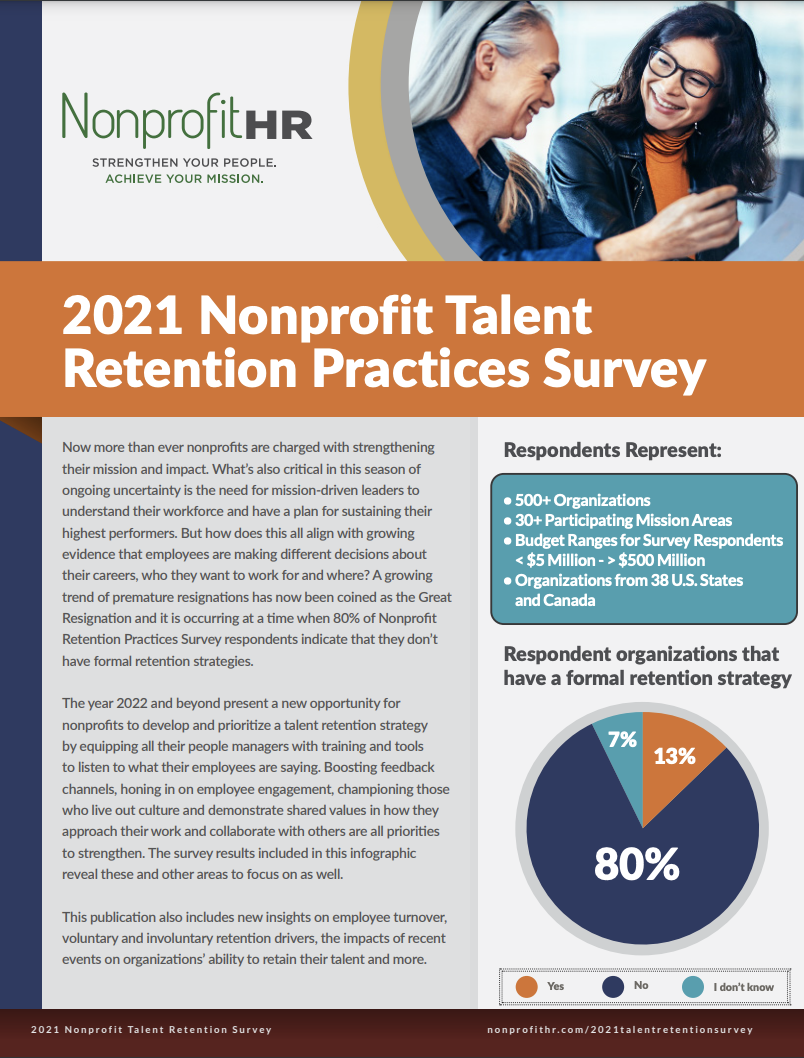WTOP: 5 ways nonprofits can…
 The Concept of Retained, Committed, Disengaged: Central to the retention conversation is often the factors of employee commitment and engagement. To simplify the difference, a retained employee is one that continues to be employed, whereas committed and engaged employees believe in, and are dedicated to, the mission of an organization. Committed and engaged employees are desirable because they are highly productive, and that productivity then provides organizations with a greater likelihood of meeting their missions. However, what happens when an employee is committed to an organization but disengaged? First, let’s look at organizational commitment.
The Concept of Retained, Committed, Disengaged: Central to the retention conversation is often the factors of employee commitment and engagement. To simplify the difference, a retained employee is one that continues to be employed, whereas committed and engaged employees believe in, and are dedicated to, the mission of an organization. Committed and engaged employees are desirable because they are highly productive, and that productivity then provides organizations with a greater likelihood of meeting their missions. However, what happens when an employee is committed to an organization but disengaged? First, let’s look at organizational commitment.
To understand organizational commitment, it’s helpful to know the different types of organizational commitment. They are classified as:
- Affective organizational commitment – This means that an employee’s beliefs and values align with that of the organization, so there is organizational fit. These employees tend to be more engaged.
- Continuance of organizational commitment – which describes when employees stay because it’s too costly, professionally, financially, or personally, to leave. These employees may or may not be engaged.
- Normative organizational commitment – which means employees stay because they feel obligated to. These employees are likely to be disengaged.
Commitment vs. Engagement, What’s the Difference?

Recognizing Disengagement for Retained, Committed and Disengaged
Some of the common signs of disengagement are higher absenteeism, lack of participation, difficulty operating as part of a team, a decline in the quality of work, pessimism instead of optimism, and greater motivation by money rather than a passion for learning. Retaining employees that are not engaged can translate to low morale through erosion of culture. Disengaged employees can influence high performers and reduce trust in, respect for, and confidence in the leaders in the organization. Those changes can then lead to employee turnover, which is costly. Also, there is a difference between an employee who is disengaged versus actively disengaged. Employees that are actively disengaged are those that feel miserable at work and spread that negativity to their colleagues. Not only are they causing the company to lose money through lower productivity, but they also pass on that negativity to other employees that they interact. They are not needed to be Retained, nor are they Committed and so Disengage from the organization.
 Download infographic for Nonprofit Talent Retention Practices Survey data and trends
Download infographic for Nonprofit Talent Retention Practices Survey data and trends
Introversion, Extroversion, and Engagement
It is worth noting that personality traits can influence how engagement is perceived. Introversion can be mistaken for disengagement, and extroversion can be mistaken for engagement. Introverts, for example, may naturally display some of the behaviors associated with disengagement. They may be less likely to speak up in team meetings or share their ideas during large group discussions, but it may not be due to a lack of engagement. It is because they may not feel comfortable sharing their thoughts in a particular setting. On the other hand, extroversion may look like speaking frequently in meetings, but these actions should not be taken as a sign of definite engagement. One key consideration is that engagement looks different for each employee, and time needs to be taken to evaluate the nature of a team and the engagement patterns individuals exhibit over time.
Measuring Engagement for Retained, Committed, and Disengaged

In addition to surveys and focus groups, stay or employee experience interviews can be very valuable, along with a constant review of turnover. Stay interviews, similarly to exit interviews, should be thought of as a research tool or another way to gather data. The results gathered from stay interviews help organizations address problems before they become an issue or an incentive for an employee to leave. Stay interviews provide an opportunity to proactively combat disengagement while it’s occurring, rather than after the employee has already made the decision to leave the organization.
Regardless of the method used, leaders need to communicate an openness to receiving feedback and create spaces that ensure that staff has a sense of comfort in expressing how they are feeling.
When seeking to combat disengagement, staff feedback can help to highlight the cause of disengagement and help to develop solutions or methods to address it. As mentioned above, the ways to gather feedback vary and needs to be tailored to each organization. Another way to combat disengagement is to create an ambassador program that pairs highly engaged staff with those who are disengaged. The aim here is for the engaged staff to help shift the mindset of those who are disengaged by offering different perspectives and support tools. The most important thing, however, is to create the space for staff to voice their challenges, which can be evaluated to develop a plan to address concerns.

|
About Chantel Simms, MBA, SPHR, SHRM-CP
Team Leader and Senior Consultant, Outsourcing
|
| Chantel is a Senior Consultant with Nonprofit HR’s Outsourcing practice area. Chantel is a multi-faceted human resources leader who champions strategic HR Management (HRM) plans to drive business success. She is known for engaging employees at all levels, has a passion for helping others, and is intentional about making a positive daily impact. Chantel has 20 years of HR experience and brings enormous depth and breadth of human resources experience in both nonprofit and for-profit industries. See Chantel’s full bio. |
|
About Aimee Wood, SHRM-CP
Consultant, Outsourcing |
| Aimee is an Associate Consultant for the firm’s Outsourcing division. She supports clients within the Law and Education industries in areas including recruiting and staffing, employee relations, human resources information systems management, employee benefits, human resource compliance, performance management, training and development and strategic planning. She appreciates the opportunity to practice human resources while supporting the missions of her nonprofit clients. See Aimee’s full bio. |
About Nonprofit HR’s Outsourcing Practice
Nonprofit HR’s Outsourcing practice gives your organization all the benefits of an in-house HR team, but with less internal full-time staff and more expertise. Our dedicated HR consultants can manage all aspects of your human resources function, from talent acquisition and onboarding to workforce planning and employee relations. Packages are available for as few as twenty hours per month and can be tailored to any budget. Want to learn more about HR Outsourcing or simply have a question? Contact us now.































